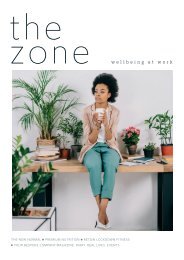THE ZONE
A wellbeing publication for businesses wanting to tell their wellbeing story. Produced by national journalists we provide in-depth features on everything you need to engage your staff regarding wellbeing at work, from our environment to physical and mental wellbeing. In every issue we feature a people story, a workspace story, an interview with a leading figure in wellbeing as well as nutrition, self development, and exercise - and we cover all the latest trends in our news pages. The unique offering allows each company to own their content with bespoke pages where you can share staff news, your wellbeing diary and your vision - as well as your company logo on the cover. We aim to inspire, and encourage all our readers to always see the bigger picture. In our first issue we're delighted to feature an exclusive interview with Paula Radcliffe, who explains running is more than just sport - it makes her feel alive!
A wellbeing publication for businesses wanting to tell their wellbeing story. Produced by national journalists we provide in-depth features on everything you need to engage your staff regarding wellbeing at work, from our environment to physical and mental wellbeing. In every issue we feature a people story, a workspace story, an interview with a leading figure in wellbeing as well as nutrition, self development, and exercise - and we cover all the latest trends in our news pages. The unique offering allows each company to own their content with bespoke pages where you can share staff news, your wellbeing diary and your vision - as well as your company logo on the cover. We aim to inspire, and encourage all our readers to always see the bigger picture. In our first issue we're delighted to feature an exclusive interview with Paula Radcliffe, who explains running is more than just sport - it makes her feel alive!
Create successful ePaper yourself
Turn your PDF publications into a flip-book with our unique Google optimized e-Paper software.
Understand your heart rate
Most wearable devices will monitor your
heart rate – as well as steps, miles run,
the pace, the elevation gained etc. But if
you want to go old school, get a stopwatch
and find your pulse, either at your wrist
or your neck. Count for 10 seconds and
multiply by six to work out how heart
beats per minute.
Whichever way you decide to measure
it, to work out whether you’re training at
the right intensity you first need to know
your Maximum Heart Rate (MHR) and
then aim to work at a percentage of that.
Maximum heart
rate (MHR)
This is the fastest your heart can beat
for one minute. Your MHR is affected by
body composition (i.e. fat percentage),
gender and genetics. There's no good or
bad MHR. It declines with age but you
cannot really change it through training
and a high heart rate isn’t necessarily a
predictor of success, it’s the efficiency of
your heart that counts.
There are many ways to find your MHR.
The simplest way is to warm up for 10
minutes, then find a hill that takes you
two minutes to ascend. Run hard five
minutes before taking on the hill. After
two hard hill reps, record your heart rate.
Check in on your MHR every six months
to ensure ongoing accuracy of your
training zones. Only do the test if you are
fit, healthy and recovered from racing.
Resting heart rate (RHR)
RHR is a good indicator of where you are
fitness-wise. If you’re over-tired, or viral it
will rise. When you're fit from marathon
training it will be lower. The average is
around 50 to 60 beats per minute and up
to 100 is healthy, but fit marathoners can
have RHR as low as 30. You will need to
have recorded your RHR to work out your
training zones. Take your pulse first thing
in the morning, before you’ve moved out
of bed. Your wearable may record it for
you automatically, and there are lots of
apps to do this, or of course, you can do it
yourself, as stated above.
Working heart rate (WHR)
Once you have an accurate figure for
MHR and RHR you can calculate your
WHR and have a more precise figure to
use for different training intensities. To
do this, first subtract your RHR from
your MHR. For example, a RHR of 50 and
MHR of 200 gives you a WHR of 150.
Next calculate a percentage of the WHR,
for example, if you want to know what
your heart rate is at 70 per cent, the sum
is 70 per cent of 150 (105). Then finally
add your RHR to this figure to get your
accurate training rate. So in this example
WHR will be 105 + 50 = 155.
QUICK
FIX:
220 MINUS YOUR AGE?
IF YOU'RE 45 YEARS OLD,
SUBTRACT 45 FROM 220
TO GET A MHR OF 175. THIS
QUICK CALCULATION IS A
ROUGH GUIDE TO MHR AND
CAN HELP YOU TRAIN AT
THE RIGHT INTENSITY (AS A
PERCENTAGE OF YOUR MAX)
MOVE
It's never been easier to measure and monitor your body's response to
exercise. Your heart can tell you when to push and when to rest.
Record your
heart rate
variability (HRV)
HRV measures the variation
between your heart beats
and gives you feedback on
your heart health and its
response to training. The app
HRV4Training records this on
your phone and links with the
Training Peaks app.
Training zones for running
l
l
l
l
l
Below 60 per cent: easy aerobic, for
example, easy jogging, recovery.
60 to 65 per cent: easy aerobic base
building, jogging to steady running.
65 to 75 per cent: marathon pace.
75 to 85 per cent: threshold/ tempo or
half marathon to 10K pace.
85 to 95 per cent: speed/ intervals,
5K or less.
32
32-33_Move (FINAL).indd 32 11/03/2020 14:13




